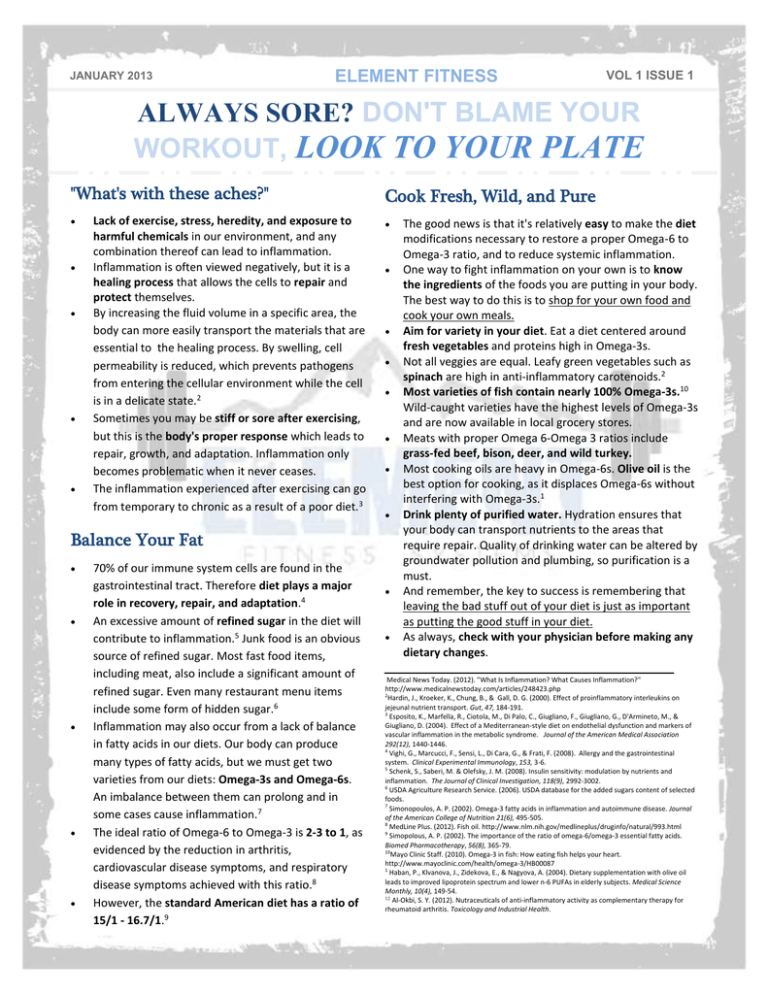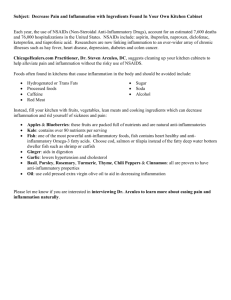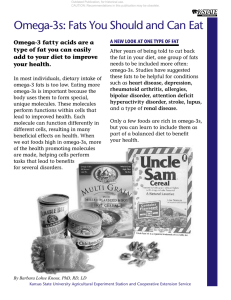ELEMENT FITNESS ELEMENTARY ALWAYS SORE? DON'T
advertisement

JANUARY 2013 ELEMENT FITNESS VOL 1 ISSUE 1 ELEMENTARY ALWAYS SORE? DON'T BLAME YOUR WORKOUT, LOOK TO YOUR PLATE "What's with these aches?" Cook Fresh, Wild, and Pure Lack of exercise, stress, heredity, and exposure to harmful chemicals in our environment, and any combination thereof can lead to inflammation. Inflammation is often viewed negatively, but it is a healing process that allows the cells to repair and protect themselves. By increasing the fluid volume in a specific area, the body can more easily transport the materials that are essential to the healing process. By swelling, cell permeability is reduced, which prevents pathogens from entering the cellular environment while the cell is in a delicate state.2 Sometimes you may be stiff or sore after exercising, but this is the body's proper response which leads to repair, growth, and adaptation. Inflammation only becomes problematic when it never ceases. The inflammation experienced after exercising can go from temporary to chronic as a result of a poor diet.3 Balance Your Fat 70% of our immune system cells are found in the gastrointestinal tract. Therefore diet plays a major role in recovery, repair, and adaptation.4 An excessive amount of refined sugar in the diet will contribute to inflammation.5 Junk food is an obvious source of refined sugar. Most fast food items, including meat, also include a significant amount of refined sugar. Even many restaurant menu items include some form of hidden sugar.6 Inflammation may also occur from a lack of balance in fatty acids in our diets. Our body can produce many types of fatty acids, but we must get two varieties from our diets: Omega-3s and Omega-6s. An imbalance between them can prolong and in some cases cause inflammation.7 The ideal ratio of Omega-6 to Omega-3 is 2-3 to 1, as evidenced by the reduction in arthritis, cardiovascular disease symptoms, and respiratory disease symptoms achieved with this ratio.8 However, the standard American diet has a ratio of 15/1 - 16.7/1.9 The good news is that it's relatively easy to make the diet modifications necessary to restore a proper Omega-6 to Omega-3 ratio, and to reduce systemic inflammation. One way to fight inflammation on your own is to know the ingredients of the foods you are putting in your body. The best way to do this is to shop for your own food and cook your own meals. Aim for variety in your diet. Eat a diet centered around fresh vegetables and proteins high in Omega-3s. Not all veggies are equal. Leafy green vegetables such as spinach are high in anti-inflammatory carotenoids.2 Most varieties of fish contain nearly 100% Omega-3s.10 Wild-caught varieties have the highest levels of Omega-3s and are now available in local grocery stores. Meats with proper Omega 6-Omega 3 ratios include grass-fed beef, bison, deer, and wild turkey. Most cooking oils are heavy in Omega-6s. Olive oil is the best option for cooking, as it displaces Omega-6s without interfering with Omega-3s.1 Drink plenty of purified water. Hydration ensures that your body can transport nutrients to the areas that require repair. Quality of drinking water can be altered by groundwater pollution and plumbing, so purification is a must. And remember, the key to success is remembering that leaving the bad stuff out of your diet is just as important as putting the good stuff in your diet. As always, check with your physician before making any dietary changes. Medical News Today. (2012). "What Is Inflammation? What Causes Inflammation?" http://www.medicalnewstoday.com/articles/248423.php 2 Hardin, J., Kroeker, K., Chung, B., & Gall, D. G. (2000). Effect of proinflammatory interleukins on jejeunal nutrient transport. Gut, 47, 184-191. 3 Esposito, K., Marfella, R., Ciotola, M., Di Palo, C., Giugliano, F., Giugliano, G., D'Armineto, M., & Giugliano, D. (2004). Effect of a Mediterranean-style diet on endothelial dysfunction and markers of vascular inflammation in the metabolic syndrome. Journal of the American Medical Association 292(12), 1440-1446. 4 Vighi, G., Marcucci, F., Sensi, L., Di Cara, G., & Frati, F. (2008). Allergy and the gastrointestinal system. Clinical Experimental Immunology, 153, 3-6. 5 Schenk, S., Saberi, M. & Olefsky, J. M. (2008). Insulin sensitivity: modulation by nutrients and inflammation. The Journal of Clinical Investigation, 118(9), 2992-3002. 6 USDA Agriculture Research Service. (2006). USDA database for the added sugars content of selected foods. 7 Simonopoulos, A. P. (2002). Omega-3 fatty acids in inflammation and autoimmune disease. Journal of the American College of Nutrition 21(6), 495-505. 8 MedLine Plus. (2012). Fish oil. http://www.nlm.nih.gov/medlineplus/druginfo/natural/993.html 9 Simopolous, A. P. (2002). The importance of the ratio of omega-6/omega-3 essential fatty acids. Biomed Pharmacotherapy, 56(8), 365-79. 10 Mayo Clinic Staff. (2010). Omega-3 in fish: How eating fish helps your heart. http://www.mayoclinic.com/health/omega-3/HB00087 1 Haban, P., Klvanova, J., Zidekova, E., & Nagyova, A. (2004). Dietary supplementation with olive oil leads to improved lipoprotein spectrum and lower n-6 PUFAs in elderly subjects. Medical Science Monthly, 10(4), 149-54. 12 Al-Okbi, S. Y. (2012). Nutraceuticals of anti-inflammatory activity as complementary therapy for rheumatoid arthritis. Toxicology and Industrial Health. MONTH DAY YEAR ph 555.555.5555 fx 555.555.5555 mo 555.555.5555 email@address.com www.webaddress.com VOL 1 ISSUE 1









